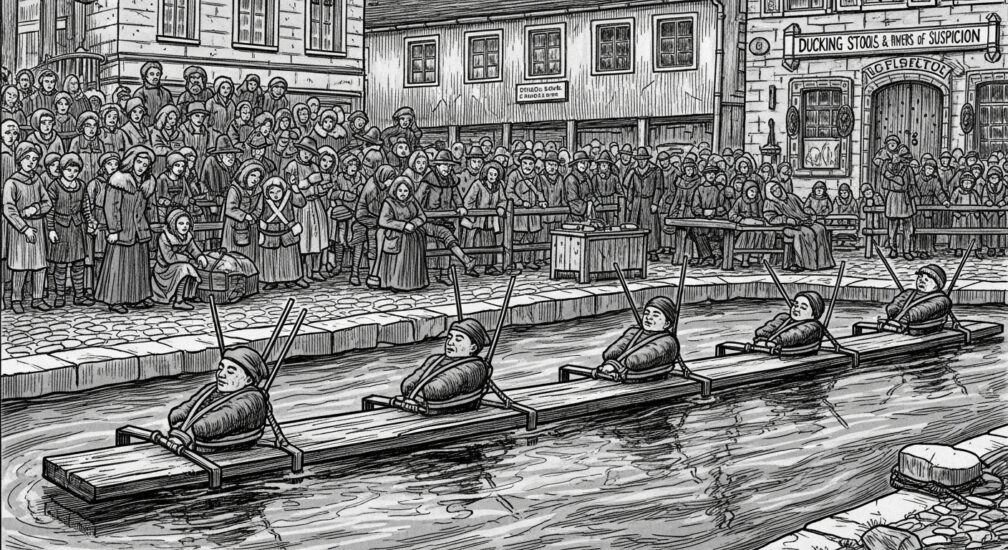Water has always symbolized life, yet in the Middle Ages it morphed into a tool of torment, coercion, and public judgment. Below we trace the history of water torture methods and reveal why these “liquid sentences” often replaced blades and racks on the punishment roster.
1. Ducking Stools & Rivers of Suspicion
What was a ducking stool used for? In village squares across Europe the answer was simple: public humiliation. Accused scolds or supposed witches were strapped to a long wooden beam and repeatedly plunged into a river. Spectators delighted in each violent immersion, convinced that repeated suffocation would force a confession. Beyond the spectacle, authorities believed the cold shock purified the soul-an early mix of ritual and crude psychology.
2. Trial by Ordeal: When Courts Let Water Judge
So how did water ordeal trials work? A tied culprit was dropped into a consecrated pond. If they sank, they were “accepted” by the water and pulled out as innocent (often half-drowned). Floating meant guilt – the water, blessed by priests, allegedly rejected evil. This blend of law and superstition supplied the legal basis for drowning sentences, positioning water as a divine lie detector.
3. Drowning Pits, Bridges, and Famous Cases
Medieval chronicles catalog dozens of famous drowning executions in the Middle Ages. From Scottish clan feuds to Burgundian political purges, swift submersion avoided messy bloodshed while sending a terrifying civic message. Records show survival rates of medieval water torture were dismal; chained ankles and stone weights ensured few prisoners resurfaced alive.
4. Liquid Interrogations Behind Castle Walls
While public duckings entertained crowds, discreet cisterns inside keeps served as water as a tool of interrogation. Jailers forced captives to inhale buckets of water-an ancestor to modern waterboarding, illustrating the stark difference between waterboarding and ducking. One focused on slow panic-inducing flooding of airways; the other relied on repeated dunk-and-gasp cycles in open water.
5. Witch-Hunt Waves: Why Accused Were Dunked
During witch crazes, courts asked why accused witches were dunked in rivers instead of burned. Water, deemed a virgin element, was thought to reject those in league with the devil. Paradoxically, absolute proof of guilt meant drowning victims perished, feeding mass hysteria, fear, and later skepticism toward such tribunals.
6. Psychological Echoes of Forced Submersion
Modern psychiatrists still analyze the psychological effects of forced submersion-claustrophobia, lasting terror of water, and flashbacks. Medieval observers lacked such vocabulary; they only noted rapid “penitence” and coerced confession. Today we recognize these reactions as trauma from deliberate brutality.
7. Liquid Punishments Across Europe
Cataloguing liquid punishments in European history reveals regional twists: Venetian “bridal chests,” German barrel drownings, and French mill-race plunges. Each shows how geography shaped cruelty-rivers, wells, even millponds became convenient prisons. Such local variations form an unsettling pan-European tapestry of aquatic pain.
8. From Moat to Museum – Where to See the Relics
Curious visitors can still confront these chilling devices. The Medieval Torture Museum in Chicago offers reconstructed ducking stools beside icy soundscapes. On the West Coast, the Medieval Torture Museum in LA merges gruesome exhibits with guides who happily list top tourist attractions in Los Angeles for a palate cleanser afterward. Florida travelers find interactive cistern recreations at the Medieval Torture Museum in St Augustine. Deeper essays and first-hand curator notes appear on our blog-perfect for those who crave every dark detail.
9. Legacy: From Drowning Pits to Due Process
Today water is policed by humanitarian law, yet echoes remain: modern navies train against maritime panic, and debate over coercive hydration persists. Understanding medieval drowning punishment explains how fragile justice once was-and why vigilance is vital against any new weapon, however ordinary its source.
Water can sustain or destroy. In the Middle Ages, society chose the latter. Learning that lesson keeps history’s deadliest weapon safely in the past.






